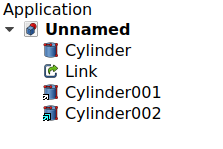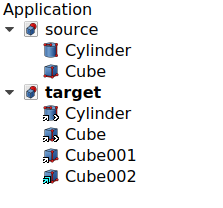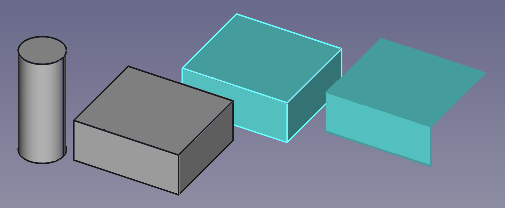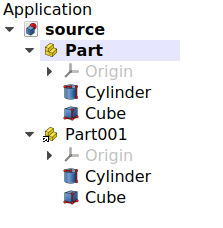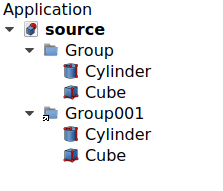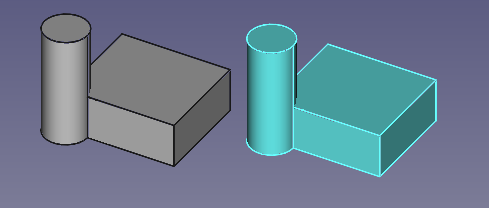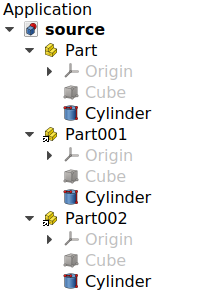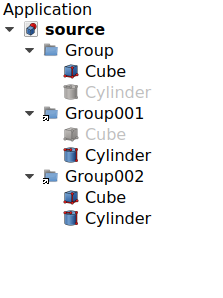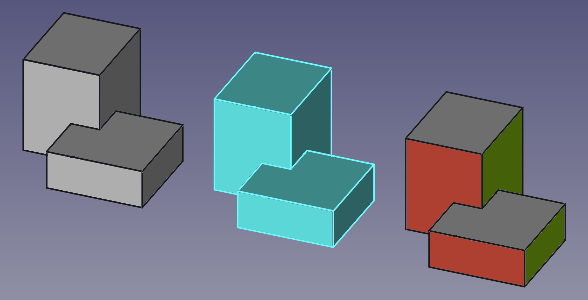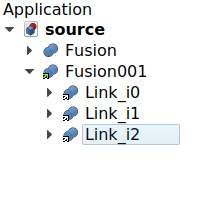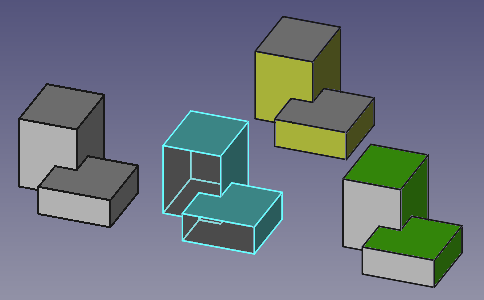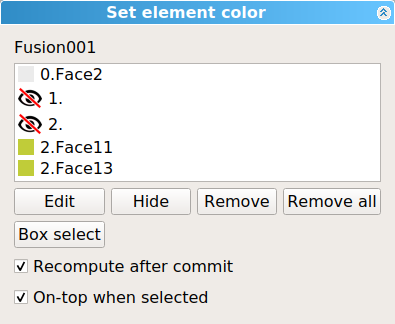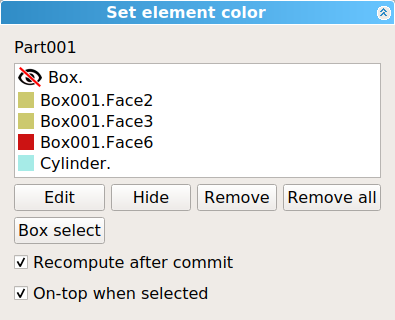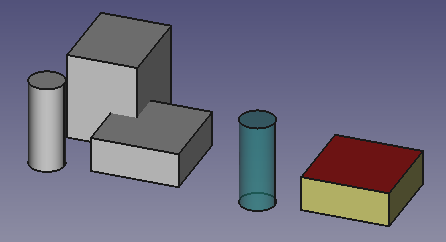Std LinkMake/pt-br
|
|
| Menu location |
|---|
| None |
| Workbenches |
| All |
| Default shortcut |
| None |
| Introduced in version |
| 0.19 |
| See also |
| Std Part, Std Group, PartDesign Body |
Descrição
Std LinkMake creates an App Link (
App::Link class), a type of object that references or links to another object in the same document, or in another document. It is especially designed to efficiently duplicate a single object multiple times, which helps with the creation of complex assemblies from smaller subassemblies, and from multiple reusable components like screws, nuts, and similar fasteners.
The App Link object was newly introduced in v0.19; in the past, simple duplication of objects could be achieved with Draft Clone, but this is a less efficient solution due to its implementation, which essentially creates a copy of the internal Shape of the source object. Instead, a Link directly references the original Shape, so it is more memory-efficient.
By itself the Link object can behave like an array, duplicating its base object many times; this can be done by setting its DadosElement Count property to 1 or larger. This "Link Array" object can also be created with the different array tools of the Draft Workbench, for example,
Draft OrthoArray,
Draft PolarArray, and
Draft CircularArray.
When used with the PartDesign Workbench, Links are intended to be used with
PartDesign Bodies, so it is recommended to set VistaDisplay Mode Body to
Tip to select the features of the entire Body, and not the individual features. To create arrays of the internal PartDesign Features, use PartDesign LinearPattern,
PartDesign PolarPattern, and
PartDesign MultiTransform.
The Std LinkMake tool is not defined by a particular workbench, but by the base system, thus it is found in the Structure toolbar that is available in all workbenches. The Link object, used in conjunction with
Std Part to group various objects, forms the basis of the
Assembly3 and
Assembly4 Workbenches.
Utilização
With selection:
Without selection:
- If no object is selected, press the
Make Link button to create an empty
Link.
- Go to the Property View, then click on the DadosLinked Object property to open the Link selection dialog to choose an object, then press OK.
- Instead of choosing an entire object in the Tree View, you can also pick subelements (vertices, edges, or faces) of a single object in the 3D View. In this case, the Link will duplicate only these subelements, and the arrow overlay will be different. This can also be done with
Std LinkMakeRelative.
(1) An object, (2) an empty Link, (3) a full Link to the first object (with overriding material), and (4) a Link to only some subelements of the object. The empty Link is not tied to the real object so it is not displayed in the 3D View.
Usage: external documents
- Start with a document that has at least one object which will be the source of the Link.
- Open a new document or an existing document. For easier handling, use
Std TreeMultiDocument to show both documents in the Tree View. Before you proceed, save both documents. The Link won't be able to find its source and target unless both documents are saved on disk.
- In the first document, select the object that you wish to link; then switch tabs in the main view area to switch to the second document.
- Press
Make Link. The produced object has the same icon as the original object, but has an additional arrow overlay indicating it is a Link coming from an external document.
Notes:
- When saving the document with the Link, it will also ask to save the source document which contains the original object.
- To include the original object in the document with the Link, use
Std LinkImport or
Std LinkImportAll.
Std LinkMake can be used on an existing Link object, in order to create a Link to a Link which ultimately resolves to the original object in the source document. This can be used with
Std LinkMakeRelative to pick only certain subelements as well.
(1, 2) Two objects from a source document linked into a target document, (3) a Link to the second Link (with overriding material), and (4) a Link to the subelements of the second Link.
Dragging and dropping
Instead of switching document tabs, you can create Links by performing a drag and drop operation in the Tree View: select the source object from the first document, drag it, then drop it into the second document's name while holding the Alt key in the keyboard.
Dragging and dropping results in different actions depending on the modifier key that is held.
- Without modifier key it simply moves the object from one document to the other; an inclined arrow is shown in the cursor.
- Holding the Ctrl key copies the object; a plus sign is shown in the cursor.
- Holding the Alt key creates a Link; a pair of chain links is shown in the cursor.
For the Ctrl and Alt modifiers, dragging and dropping can also be done with a single document. That is, dragging an object and dropping it into the same document's name can be used to create multiple copies or multiple Links to it.
Groups
Std LinkMake can be used on
Std Parts in order to quickly duplicate groups of objects positioned in space, that is, assemblies.
Link created from a Std Part; the objects are not duplicated but they are listed under the original container and under the Link container.
A regular Std Group does not possess a DadosPlacement property, so it cannot control the position of the objects inside of it. However, when
Std LinkMake is used with
Std Group, the resulting Link behaves essentially like a
Std Part, and can also be moved in space.
Link created from a Std Group; the objects are not duplicated but they are listed under the original container and under the Link container. The Link (with overriding material) can be moved in space, just like a Std Part.
A Link to a Std Part will keep the visibility of the objects synchronized with the original Part; so if you hide one object in a Link, it will be hidden in all Links and in the original object. On the other hand a Link to a
Std Group will allow independent control of the visibilities.
Left: Std Part with two objects, and two Links to the Part; the visibility of the objects is synchronized. Right: Std Group with two objects, and two Links to the Group; the visibility of the objects is independently controlled in each group.
Overriding appearance
When a Link is created, by default the VistaOverride Material is false, so the Link will have the same appearance as the original DadosLinked Object.
When VistaOverride Material is set to true, the VistaShape Material property will now control the appearance of the Link.
Regardless of the state of VistaOverride Material, it is possible to individually set the appearance of the subelements (vertices, edges, faces) of a Link.
- Select the Link in the Tree View. Open the context menu (right-click), and pick Override colors.
- Now pick the individual subelements that you want in the 3D View, press Edit, and change the properties including transparency.
- To remove the custom attributes, select the elements in the list, and press Remove.
- When you are satisfied with the result, press OK to close the dialog.
Note: as of v0.19, the coloring of the subelements is subject to the topological naming problem so it should be done as the last modelling step, when the model is not subject to change any more.
(1) An original object, (2) a Link with overriding material, and (3) a second Link with individual modified subelements.
Link Array
See also: Draft OrthoArray.
When a Link is created, by default its DadosElement Count is 0, so only a single Link object will be visible in the Tree View.
Given that DadosShow Element is true by default, when DadosElement Count is set to 1 or more, automatically more Links will be created below the first one; each new Link can be placed in the desired position by changing its own DadosPlacement property.
In similar way, each element of the array can have its own appearance changed, either by the VistaOverride Material and VistaShape Material properties, or by using the Override colors menu on the entire array and then selecting individual faces; this is described in Overriding appearance.
(1) Original object, and (2, 3, 4) a Link array with three elements, each in a different position. The first Link has overridden material and transparent faces, the other two have custom face colors.
Once you are satisfied with the placement and properties of the Link elements in the array, you may change DadosShow Element to false in order hide the individual Links in the Tree View; this has the benefit of making the system more responsive, particularly if you have many objects in the document.
When creating this type of Link array, you must place each of the elements manually; however, if you would like to use specific patterns to place the copies, you may use the array tools of the Draft Workbench, like
Draft OrthoArray,
Draft PolarArray, and
Draft CircularArray; these commands can create normal copies or Link copies depending on the options at creation time.
Visibility
When DadosShow Element is true and individual elements are listed in the Tree View in a Link Array, each Link can be shown or hidden by pressing the Space bar in the keyboard.
Another way to hide the individual elements is using the Override colors menu.
- Select the array, open the Override colors menu (right click).
- In the 3D View, pick any subelement from any Link in the array.
- Press Hide. An icon of an eye
should appear, indicating that this element has been hidden from the 3D View. The object will temporarily show itself when the cursor hovers over the
icon.
- You can click OK to confirm the operation and close the dialog. The Link will remain hidden even if it is shown as visible in the Tree View.
Element color dialog that is available when opening the context menu of a Link object in the Tree View.
If you wish to restore the visibility of this array element, enter the dialog once more, pick the eye icon, then click on Remove to remove the hidden status, and click OK to confirm and close the dialog. The element will be visible in the 3D View again.
When the Link is for a Std Part or a
Std Group, the Override colors menu works in similar way as with arrays; it allows controlling the face color, entire object color, and visibility of the objects in the group.
A Std Part containing three objects, and a Link to that Part; in the Link, (1) the first object is made invisible, (2) the second object has some subelements with different colors, (3) the entire third object has a different color and level of transparency.
Properties
An App Link (App::Link class) is derived from the basic App DocumentObject (App::DocumentObject class), therefore it has the latter's basic properties like DadosLabel and DadosLabel2.
The following are the specific properties available in the Property View. Hidden properties can be shown by using the Show hidden command in the context menu of the Property View.
See Part Feature for an explanation of some of the properties listed below.
Data
Link
- DadosLinked Object (
XLink): it indicates the source object of the App Link; this can be an entire object, or a subelement of it (vertex, edge, or face). - DadosLink Claim Child (
Bool): claim the linked object as a child. - DadosLink Transform (
Bool): it defaults tofalse, in which case the Link will override the DadosLinked Object's own placement. If it is set totrue, the Link will be placed in the same position as the DadosLinked Object, and its placement will be relative to the DadosLinked Object's placement. This can also be achieved withStd LinkMakeRelative.
- Dados (Hidden)Link Placement (
Placement): it is an offset applied on top of the DadosPlacement of the DadosLinked Object. This property is normally hidden but appears if DadosLink Transform is set totrue; in this case, DadosPlacement now becomes hidden. - DadosPlacement (
Placement) - DadosShow Element (
Bool): it defaults totrue, in which case the Tree View will show the individual Link copies, as long as DadosElement Count is1or larger. - DadosElement Count (
IntegerConstraint): element count. It defaults to0. If it is1or larger, the App Link will behave like an array, and will duplicate the same DadosLinked Object many times. If DadosShow Elements istrue, each element in the array will be displayed in the Tree View, and each can have its own DadosPlacement modified. Each Link copy will have a name based on the Link's Name, augmented by_iN, whereNis a number starting from0. For example, with a singleLink, the copies will be namedLink_i0,Link_i1,Link_i2, etc. - DadosLink Execute (
String): name of the execute function that will run for this particular Link object. It defaults to'appLinkExecute'. Set it to'None'to disable it. - Dados (Hidden)Colored Elements (
LinkSubHidden): list of Link elements that have had their color overriden. - DadosLink Copy On Change (
Enumeration):Disabled: disable the creation of a copy of the linked object, triggered by a change of any of its properties set asCopyOnChange.Enabled: enable a deep copy of the linked object if any of its properties marked asCopyOnChangeare changed. After the deep copy is performed, there won't be any linkage between the original and the copied object. Therefore, changes in the original object won't be reflected in the copies. Note: this is a preparatory state, the actual copy will only happen onceCopyOnChangeproperties are changed. See theOwnedstate.Owned: indicates that the linked object has been copied, and the copy is owned by the Link. This state is set by the Link automatically, not by the user. The workflow is as follows: if the state isEnabledand the user modifies any properties previously set asCopyOnChange, then the state is changed toOwned. That's the point in time when the Link will perform the deep copy of the linked object. In this state, the link will not try to sync any changes of the original linked object back to the copy.Tracking: same asEnabled, but additionally the copy will be automatically refreshed if the original source object changes.
- Dados (Hidden)Link Copy On Change Source (
XLink): the copy on change source object. - Dados (Hidden)Link Copy On Change Group (
Link): linked to a internal group object for holding on change copies. - Dados (Hidden)Link Copy On Change Touched (
Bool): indicating the copy on change source object has been changed. - DadosScale (
Float): it defaults to1.0. It is a factor for uniform scaling in each directionX,Y, andZ. For example, a cube of2 mmx2 mmx2 mm, that is scaled by2.0, will result in a shape with dimensions4 mmx4 mmx4 mm. - Dados (Hidden)Scale Vector (
Vector): the scale factor for each component(X, Y, Z)for all Link elements when DadosElement Count is1or larger. If DadosScale is other than1.0, this same value will be used in the three components. - DadosScale List (
VectorList): the scale factor for each Link element. - DadosVisibility List (
BoolList): the visibility state of each Link element. - DadosPlacement List (
PlacementList): the placement for each Link element. - Dados (Hidden)Element List (
LinkList): the list of Link elements. - Dados (Hidden)_ Link Touched (
Bool): TBD. - Dados (Hidden, ReadOnly)_ Child Cache (
LinkList): TBD. - Dados (Hidden)_ Link Owner (
Integer): TBD.
Base
- Dados (Hidden)Proxy (
PythonObject)
The App Link object will additionally show the properties of the original DadosLinked Object, so the Property View may have groups of properties like Attachment, Box, Draft, etc.
View
Link
- VistaDraw Style (
Enumeration) - VistaLine Width (
FloatConstraint) - VistaOverride Material (
Bool): it defaults tofalse; if set totrueit will override the DadosLinked Object's material, and it will display the colors defined in VistaShape Material. - VistaPoint Size (
FloatConstraint)
- VistaShape Material (
Material)
Base
- Vista (Hidden)Child View Provider (
PersistentObject): TBD. - Vista (Hidden, ReadOnly)Material List (
MaterialList): if individual materials have been added, they will be listed here. - Vista (Hidden, ReadOnly)Override Color List (
ColorList): if the individual faces or edges of the link have been overridden they will be listed here. - Vista (Hidden, ReadOnly)Override Material List (
BoolList): if the individual materials of the link have been overridden they will be listed here.
Display Options
- VistaDisplay Mode (
Enumeration):'Link'or'ChildView'. - VistaShow In Tree (
Bool) - VistaVisibility (
Bool)
Selection
- VistaOn Top When Selected (
Enumeration) - VistaSelection Style (
Enumeration)
It will additionally show the view properties of the original DadosLinked Object.
Inheritance
An App Link is formally an instance of the class App::Link, whose parent is the basic App DocumentObject (App::DocumentObject class). It is a very low level object, which can be used with most other document objects.
Simplified diagram of the relationships between the core objects in the program. The App::Link object is a core component of the system, it does not depend on any workbench, but it can be used with most objects created in all workbenches.
Scripting
See also: FreeCAD Scripting Basics, and scripted objects.
See Part Feature for the general information.
An App Link is created with the addObject() method of the document. It can define its DadosLinked Object by overriding its LinkedObject attribute, or by using its setLink method.
import FreeCAD as App
doc = App.newDocument()
bod1 = App.ActiveDocument.addObject("Part::Box", "Box")
bod2 = App.ActiveDocument.addObject("Part::Cylinder", "Cylinder")
bod1.Placement.Base = App.Vector(10, 0, 0)
bod2.Placement.Base = App.Vector(0, 10, 0)
obj1 = App.ActiveDocument.addObject("App::Link", "Link")
obj2 = App.ActiveDocument.addObject("App::Link", "Link")
obj1.LinkedObject = bod1
obj2.setLink(bod2)
obj1.Placement.Base = App.Vector(-10, -10, 0)
obj2.Placement.Base = App.Vector(10, -10, 0)
obj1.ViewObject.OverrideMaterial = True
App.ActiveDocument.recompute()
The basic App::Link doesn't have a Proxy object so it can't be fully used for sub-classing.
Therefore, for Python subclassing, you should create the App::LinkPython object.
import FreeCAD as App
doc = App.newDocument()
obj = App.ActiveDocument.addObject("App::LinkPython", "Link")
obj.Label = "Custom label"
Further reading
If you want to skip the historical details, go to the user-oriented introduction to links.
The App Link object was introduced after 2 years of development and prototyping. This component was thought and developed almost single-handedly by user realthunder. The motivations and design implementations behind this project are described in his GitHub page, Link. In order to accomplish this feature, several core changes to FreeCAD were made; these were also extensively documented in Core-Changes.
The App Link project started after the redesign of the PartDesign Workbench was complete in v0.17. The history of App Link can be traced to some essential forum threads:
- Why an object can only be inside one App::Part? (March 2017)
- Introducing App::Link/XLink (March 2017)
- Links (May 2017)
- Realthunder Link implementation: Architecture discussion (June 2017)
- PR #876: Link, stage one, context aware selection (July 2017)
- Preview: Link, stage two, API groundwork (July 2017)
- Assembly3 preview (December 2017)
- Merging of my Link branch (June 2018)
Finally, the pull request and merge happened:
- App::Link: the big merge, old thread (July 2019), pull request #2350 (the BIG merge), LinkMerge branch.
- App::Link: the big merge, main thread (July 2019)
- A simple path description of Link, 019, Link stage, Asm3, merge? (August 2019)
- PR#2559: expose link and navigation actions, an introduction to the Link feature in 0.19 (September 2019).
Other miscellaneous "links" about Link include:
- Dynamic linked object - A pattern with Link and assemblies that aims to reduce duplication of assembly related logic such as orientation, positioning, or number of instances.
- File: New, Open, Open Recent, Close, Close All, Save, Save As, Save a Copy, Save All, Revert, Import, Export,Merge project, Document information, Print, Print preview, Export PDF, Exit
- Edit: Undo, Redo, Cut, Copy, Paste, Duplicate selection, Refresh, Box selection, Box element selection, Select All, Delete, Send to Python Console, Placement, Transform, Alignment, Toggle Edit mode, Properties, Edit mode, Preferences
- View:
- Miscellaneous: Create new view, Orthographic view, Perspective view, Fullscreen, Bounding box, Toggle axis cross, Clipping plane, Persistent section cut, Texture mapping, Toggle navigation/Edit mode, Material, Appearance, Random color, Color per face, Toggle transparency, Workbench, Status bar
- Standard views: Fit all, Fit selection, Align to selection, Isometric, Dimetric, Trimetric, Home, Front, Top, Right, Rear, Bottom, Left, Rotate Left, Rotate Right, Store working view, Recall working view
- Freeze display: Save views, Load views, Freeze view, Clear views
- Draw style: As is, Points, Wireframe, Hidden line, No shading, Shaded, Flat lines
- Stereo: Stereo red/cyan, Stereo quad buffer, Stereo Interleaved Rows, Stereo Interleaved Columns, Stereo Off, Issue camera position
- Zoom: Zoom In, Zoom Out, Box zoom
- Document window: Docked, Undocked, Fullscreen
- Visibility: Toggle visibility, Show selection, Hide selection, Select visible objects, Toggle all objects, Show all objects, Hide all objects, Toggle selectability
- Toolbars: File, Edit, Clipboard, Workbench, Macro, View, Individual views, Structure, Help, Lock toolbars
- Panels: Tree view, Property view, Model, Selection view, Python console, Report view, Tasks, DAG view
- Dock window overlay: Toggle overlay for all, Toggle transparent for all, Toggle overlay, Toggle transparent, Bypass mouse events in docked overlay windows, Toggle left, Toggle right, Toggle top, Toggle bottom
- Link navigation: Go to linked object, Go to the deepest linked object, Select all links
- Tree view actions: Sync view, Sync selection, Sync placement, Pre-selection, Record selection, Single document, Multi document, Collapse/Expand, Initiate dragging, Go to selection, Selection back, Selection forward
- Tools: Edit parameters, Save image, Load image, Scene inspector, Dependency graph, Export dependency graph, Document utility, Add text document, View turntable, Units converter, Customize, Addon manager, Measure
- Macro: Macro recording, Macros, Recent macros, Execute macro, Attach to remote debugger, Debug macro, Stop debugging, Step over, Step into, Toggle breakpoint
- Help: Help, FreeCAD Website, Donate, Users documentation, Python scripting documentation, Automatic Python modules documentation, FreeCAD Forum, FreeCAD FAQ, Report a bug, About FreeCAD, What's This, Start
- Additional:
- Miscellaneous: Create part, Create group, Create a variable set, Make link group, Select all instances, Toggle freeze
- Create datums: Create coordinate system, Create datum plane, Create datum line, Create datum point
- Link tools: Make link, Make sub-link, Replace with link, Unlink, Import links, Import all links
- Expression actions: Copy selected, Copy active document, Copy all documents, Paste
- Selection filter: Vertex selection, Edge selection, Face selection, All selection filters cleared
- Getting started
- Installation: Download, Windows, Linux, Mac, Additional components, Docker, AppImage, Ubuntu Snap
- Basics: About FreeCAD, Interface, Mouse navigation, Selection methods, Object name, Preferences, Workbenches, Document structure, Properties, Help FreeCAD, Donate
- Help: Tutorials, Video tutorials
- Workbenches: Std Base, Assembly, BIM, CAM, Draft, FEM, Inspection, Material, Mesh, OpenSCAD, Part, PartDesign, Points, Reverse Engineering, Robot, Sketcher, Spreadsheet, Surface, TechDraw, Test Framework
- Hubs: User hub, Power users hub, Developer hub
